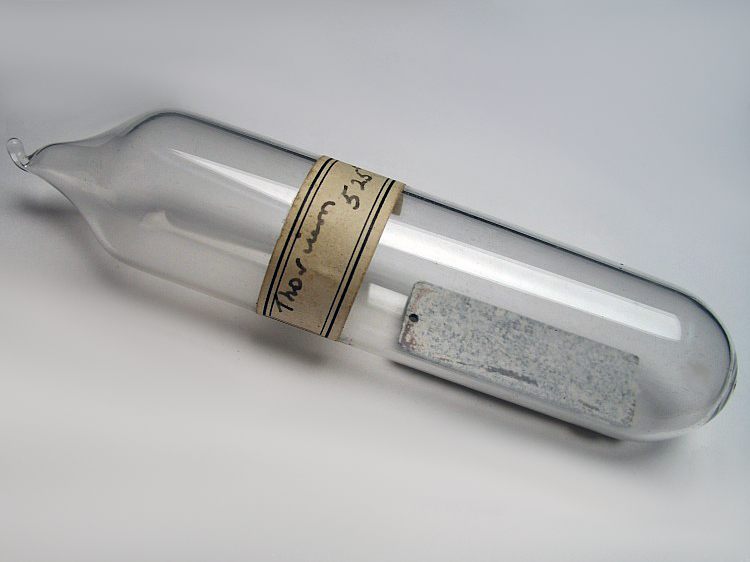The Mysterious Case of the Radioactive Toothpaste
Manhattan Project experts got sidetracked in their pursuit of Nazi nuclear technology.

In addition to developing the weapon that changed … well … everything, the Manhattan Project is the source of countless fascinating stories of innovation and intrigue. But not all of them can be considered successes, in retrospect. Sometimes they are tales of blind alleys, lost causes, and honest failures. There is, among these stories, the case of the secret team that was tracking Nazi attempts to develop nuclear technology during World War II—and instead found a nuclear-tinged marketing scheme. It came to be known as “Operation Toothpaste.”
While scientists in the United States were working to build the first atomic bomb, there was also a covert off-shoot mission to determine whether the Nazis were doing the same thing. The Alsos Mission, punnily named for the Greek word for “grove”—as in General Leslie Groves, director of the Manhattan Project—was an international operation of scientific, intelligence, and military officials tasked with understanding Germany’s technological capabilities. Established in 1943, the Alsos team performed operations throughout Europe during the later stages of World War II.

“Like many things in the Manhattan Project, there was a scientific leader, who was Samuel Goudsmit, he was a Dutch physicist. There was also an intelligence, rough-and-tumble guy named Pash. Colonel Boris Pash,” says Alex Wellerstein, science historian and author of the nuclear history blog, Restricted Data. Pash and his men followed on the heels of Allied forces as they advanced in the European theater. They seized scientists, sensitive scientific data, and atomic materials, which Goudsmit’s team then analyzed and interpreted. “It’s sort of an intelligence mission, it’s sort of a science mission,” says Wellerstein.
According to Goudsmit’s book, titled Alsos, French intelligence gave Alsos a tip about a “German chemical concern,” called Auer-Gessellschaft, that had shown a keen interest in collecting uranium. Auer was primarily in the business of making gas masks, carbon filaments, and other chemical-based war materials. Goudsmit and his team also discovered that, during the occupation of Paris, Auer controlled a smaller French firm that held a monopoly on the rare radioactive material thorium. Alarmingly, the firm’s entire supply of the substance had been moved out of Paris just before its liberation in August 1944. It was no great stretch for Alsos to theorize that Auer could be connected to a German atomic program, and that the smuggled thorium could be critical to it.
“The thorium mystery became an obsession,” Goudsmit writes. Alsos discovered that the Paris firm had been run by a “stooge” named Petersen, with the help of his secretary, Fraülein Wessel. In his book, Goudsmit describes Petersen as “not too bright,” and suggests his secretary was the real brains of the operation.

Petersen and Wessel had cleared their offices of evidence before fleeing Paris, and it appeared that Petersen had returned to Germany. Wessel, however, was tracked to the Belgian border city of Eupen, which had just been retaken by the Allies. According to Goudsmit’s account, Pash, unwilling to wait for authorization from counterintelligence officials, immediately got in his jeep with some men and went off to get her. Alsos’s legal authority to arrest these foreign nationals was somewhat suspect, but that didn’t stop Pash. “The Manhattan Project had way more autonomy than people realize,” says Wellerstein. “Alsos itself was its own sort of foreign intelligence agency.”
Wellerstein says that Pash was a rough and overzealous military man, and he often came into conflict with scientific personnel. But in this case, his bravado paid dividends. A few days later, Pash called Goudsmit to report that he had captured not just Wessel, but also the hapless Petersen, who was just visiting but was trapped in Eupen when the Allies took it. “Here was our first real Alsos Mission prisoner,” writes Goudsmit.
Petersen was in possession of detailed documents and records, which told Alsos exactly where the secreted thorium ended up. This appeared to be a huge coup for the Alsos Mission—but any excitement was short-lived. The Auer company, it turns out, was already thinking about the future, about getting out of the war business. They had decided to go all-in on one of their consumer products: thorium toothpaste.

According to Goudsmit, Auer had been “impressed by American methods of advertising,” including Bob Hope’s endorsement of Pepsodent toothpaste, which was advertised as including something called “irium.” There is, it was later revealed, no such thing as irium. Auer-Gessellschaft, like many companies at the time, was trying to get in on the craze for all things radioactive—including cosmetics. “In Germany, it would be thorium, the scientific toothpaste!” writes Goudsmit.
By early 1945, Alsos determined that the Nazis had no nuclear technology program worth crowing about, and by the end of spring, the war in Europe was over. “As it became clear from what they were finding, that Germany had not made very much progress, the goal of the mission shifted a bit and became about denying nuclear materials and expertise to the Soviet Union,” says Wellerstein.
While the thorium toothpaste caper didn’t exactly change the course of history, Alsos went on to a number of substantial achievements. The mission eventually seized a large amount of Germany’s uranium stockpile, which kept it out of the hands of Soviets and others. But first they had to cut their teeth on the case of the mysterious thorium toothpaste.














Follow us on Twitter to get the latest on the world's hidden wonders.
Like us on Facebook to get the latest on the world's hidden wonders.
Follow us on Twitter Like us on Facebook